IN ORDINE ALFABETICO / IN ALPHABETICAL ORDER
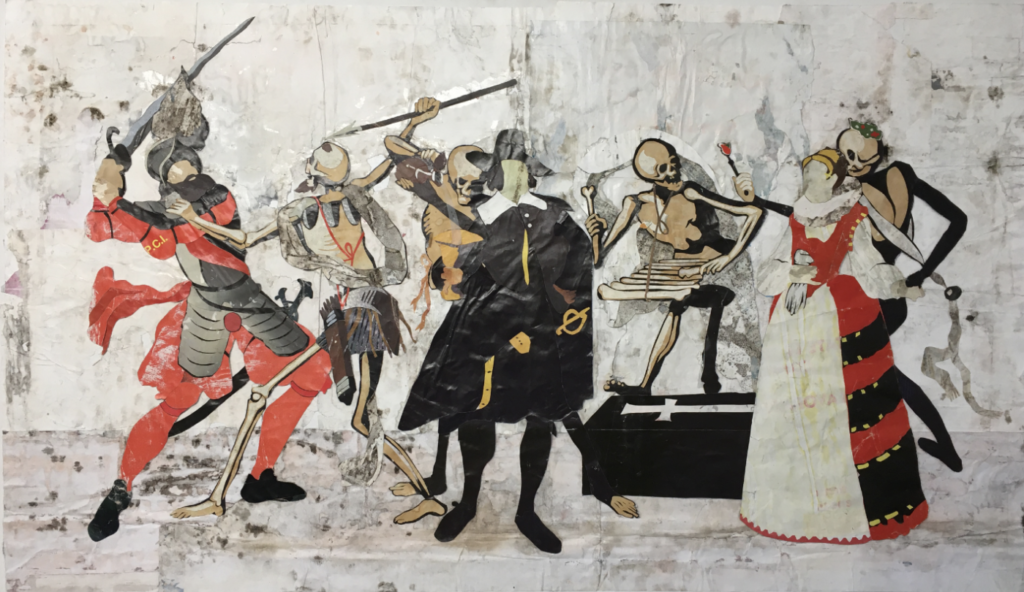
GUIDO AIROLDI
Airoldi, protagonista di un’arte fatta di materiali poveri rivitalizzati, trova in questa iconografia il recupero di un’esistenza terrena da ora rivolta alla riflessione verso i veri valori della vita di un uomo che abbandona l’attimo fuggente delle apparenze. Il ciclo delle Danze Macabre di Pinzolo, da cui quest’opera è tratta, raffigura il ballo della morte di 18 scheletri e personaggi della società cinquecentesca. Ogni coppia è accompagnata da didascalie in volgare che indicano i crudeli e a volte spietati avvertimenti della morte al genere umano. / Airoldi, protagonist of an art made of revitalized poor materials, finds in this iconography the recovery of an earthly existence aimed at reflection towards the true values of life: a man who abandons the emptiness of appearances towards a more conscious existence. The cycle of the Macabre Dances of Pinzolo, from which this work is taken, depicts the dance of death of 18 skeletons and characters of sixteenth-century society. Each pair is accompanied by vulgar captions indicating the cruel and sometimes ruthless warnings of death to mankind.
ANGELO ALESSANDRINI
La pittura di Thomas Benjamin Kenningtonr ci parla di un’intimità ripresa di nascosto, del gesto di una ragazza che libera la fantasia sognando di predere dei pesci rossi che nuotano in un oceano tutto mentale. Il tutto viene espresso con una pittura morbida, soave e sognante che Alessandrini declina attraverso morbide pennellate che ci conducono nella dimensione fantastica e sognante dei bambini che, attraverso i sogni ed il gioco, ci parlano di un mondo all’insegna dell’innocenza. / Thomas Benjamin Kenningtonr’s painting speaks to us of an intimacy hidden away, of the gesture of a girl who frees her imagination by dreaming of catching goldfish swimming in an entirely mental ocean. Everything is expressed with a soft, gentle and dreamy painting that Alessandrini declines through soft brushstrokes that lead us into the fantastic and dreamy dimension of children who, through dreams and play, speak to us of a world full of innocence.
FRANCO ANGELI
Gli Half Dollar di Angeli degli anni ‘60 ci mostrano il dominio dell’impero finanziario degli Stati Uniti d’America che iniziava a far sentire la sua influenza anche nelle arti visive. Angeli ci dona la rappresentazione sintetica dei simboli del potere economico, politico e religioso che, con la loro violenza, hanno caratterizzato e sconvolto il nostro Novecento. Il taglio fotografico è frontale ed immediato, come se ci trovassimo di fronte ad un cartellone stradale il cui impatto non ci lascia scampo. / Angeli’s Half Dollars from the 1960s show us the dominance of the financial empire of the United States of America which began to make its influence felt even in the visual arts. Angeli gives us the synthetic representation of the symbols of economic, political and religious power that, with their violence, have characterized and upset our twentieth century. The photographic cut is frontal and immediate, as if we were in front of a street billboard whose impact leaves us no way out.
ARMAN
Icona mediatica e culturale, la Nike di Samotracia, o Vittoria Alata, è emblema della perfezione della statuaria greca. La giovane dea alata figlia di Pallante e di Stige viene ripresa da Arman in un gesto dissacrante rispetto alla tradizione scultorea, sezionando le forme classiche innestandovi momenti di contemporaneità secondo il linguaggio del Nouveau Réalisme che mira al recupero di materiali e forme verso nuove identità iconografiche. / A media and cultural icon, the Nike of Samothrace, or Winged Victory, is the emblem of the perfection of Greek statuary. The young winged goddess daughter of Pallante and Styx is taken up by Arman in a desecrating gesture with respect to the sculptural tradition, dissecting the classical forms by inserting moments of contemporaneity according to the language of the Nouveau Réalisme which aims at the recovery of materials and forms towards new iconographic identities.
BANKSY
Andy Warhol cita Piero della Francesca e Banksy cita Warhol nell’azione culturalmente più significativa dell’arte del secondo Novecento: firmare il denaro. Mentre nei dollari di Warhol il soggetto dell’opera è la firma stessa dell’artista, che nobilitò così il nome dell’artefice dell’opera portandolo ad una condizione di brand come i grandi marchi che conosciamo attraverso la pubblicità, Banksy firma le sue monete, usate durante la sua installazione Dismaland, nel retro lasciando il fronte dedicato ai suoi celebri stencil. / Andy Warhol cites Piero della Francesca and Banksy cites Warhol in the most culturally significant action of art of the late twentieth century: signing money. While in Warhol’s dollars the subject of the work is the artist’s own signature, who thus ennobled the name of the author of the work bringing it to a brand condition like the big brands we know through advertising, Banksy signs his coins , used during his installation Dismaland, on the back leaving the front dedicated to his famous stencils.
MANUELA BEDESCHI
La ripresa dell’epigrafia latina viene riletta nelle opere di Manuela Bedeschi attraverso l’utilizzo del neon, medium che permette alla luce di farsi veicolo concreto della trasmissione del linguaggio visivo. Bedeschi è capace di trasportarci in ambientazioni di energia smaterializzata che riflettono su colore, luminosità, segno, forma e significato in una comunicazione fenomenologica poliedrica che conduce l’artista verso un’introspezione che ora investe lo spazio circostante. / The resumption of Latin epigraphy is reinterpreted in the works of Manuela Bedeschi through the use of neon, a medium that allows light to become a concrete vehicle for the transmission of visual language. Bedeschi is able to transport us into environments of dematerialized energy that reflect on color, brightness, sign, shape and meaning in a multifaceted phenomenological communication that leads the artist towards an introspection that now invests the surrounding space.
UMBERTO BIGNARDI
Bignardi riprende in quest’opera le celebri sequenze fotografiche di Eadweard Muybridge, fotografo inglese che sperimentò il movimento nella fotografia: i suoi studi e le sue immagini sono stati fondamentali per l’evoluzione della tecnica fotografica, oltre ad influenzare la pittura e la scultura. Bignardi riproduce la celebre sequenza della scimmia di Muybridge trasformandola non in esperimento fotografico sul movimento, ma in un’icona immobile, tangibile e concreta. / Bignardi takes up in this work the famous photo sequences of Eadweard Muybridge, an English photographer who experimented with movement in photography: his studies and his images were fundamental for the evolution of photographic technique, as well as influencing painting and sculpture. Bignardi reproduces the famous sequence of Muybridge’s monkey transforming it not into a photographic experiment on movement, but into an immobile, tangible and concrete icon.
BEPPE BORELLA
Comparsi per la prima volta attorno alla fine degli anni ‘70, gli omini della Lego sono considerati una delle icone più celebri nel mondo dei giocattoli. Beppe Borella scolpisce il marmo e si appropria di questo soggetto per creare una disambiguità sensoriale: un omino di plastica dal peso irrisorio trasformato in una scultura in marmo con un tablet o un telefonino in mano: pensando alla Generazione Y Millennials cresciuti nell’era di Internet creando una dipendenza di distacco dalla realtà. / Appearing for the first time around the end of the 1970s, the Lego men are considered one of the most famous icons in the world of toys. Beppe Borella sculpts marble and appropriates this subject to create a sensory disambiguity: a small plastic man with a negligible weight transformed into a marble sculpture with a tablet or mobile phone in his hand: thinking of Generation Y Millennials who grew up in the Internet age creating an addiction of detachment from reality.
TANO FESTA
L’opera di Michelangelo, ancora una volta, viene presa a piene mani e contemporaneizzata. Il particolare dell’Adamo è qui presentato nel gesto più significativo: il tentativo di toccare Dio come chiaro simbolo del libero arbitrio. La serie appare un tributo alla storia dell’arte presentata ora come un cartellone pubblicitario dai colori esplosivi creando così un’opera universalmente riconoscibile che sfrutta gli elementi più popolari e non legati ad un pubblico prevalentemente colto. / Once again, Michelangelo’s work is taken with both hands and contemporary. The detail of Adam is presented here in the most significant gesture: the attempt to touch God as a clear symbol of free will. The series appears as a tribute to the history of art now presented as an advertising billboard with explosive colors, thus creating a universally recognizable work that exploits the most popular elements that not linked to a predominantly cultured audience.
TANO FESTA
Le celebri piazze del Canaletto vengono private della resa pittorica tipica dell’artista veneziano. Negli anni della riproducibilità tecnica dell’immagine la sua reiterazione viene realizzata da Tano Festa attraverso l’emulsione fotografica. In una grande camera oscura l’immagine scelta viene proiettata su una tela cosparsa di emulsione ed impressa in bianco e nero. Successivamente viene lavorata con l’acrilico diluito alla nitro per creare un’immagine che spersonalizza il calore della pittura settecentesca. / Canaletto’s famous squares are deprived of the typical pictorial rendering of the Venetian artist. In the years of the technical reproducibility of the image, its reiteration was carried out by Tano Festa through photographic emulsion. In a large dark room, the chosen image is projected onto a canvas sprinkled with emulsion and printed in black and white. It is then worked with diluted nitro acrylic to create an image that depersonalizes the warmth of eighteenth-century painting.
GIOSETTA FIORONI
La sensibilità della Venere dormiente è ora oggetto della reinterpretazione soave e delicata della Fioroni. Celebre per i suoi smalti argentati, l’artista ricama una poesia fatta di tratti dormienti che rievocano un risveglio disincantato ricco di allusioni e rimandi al limite tra sogno e realtà. I diversi piani di composizione sono sovrapposti in un’estasi che ci fa rivivere la pittura del Giorgione e del Tiziano non in chiave pittorica, ma traslata verso un’icona rappresentata con tratto netto ed essenziale. / The sensitivity of the sleeping Venus is now the subject of Fioroni’s sweet and delicate reinterpretation. Famous for his silver enamels, the artist embroiders a poem made up of dormant features evoking a disenchanted awakening full of allusions and references to the limit between dream and reality. The different levels of composition are superimposed in an ecstasy that makes us relive the painting of Giorgione and Titian not in a pictorial key, but translated towards an icon represented with a clear and essential line.
MASSIMO GURNARI
Il Cristo penitente di Frangipane è un ritratto potente che mostra il Cristo sofferente nella sua condizione di umana sofferenza. Guardando dritto allo spettatore con sguardo profondamente addolorato, sembra volerci comunicare tutto il pathos del momento. Da sempre affascinato dalla storia sacra, Gurnari realizza l’opera con la cera, allusione alle candele degli altari e alle offerte che lo riporta ad un sentimento di caducità e pentimento di un’umanità volta a prostrarsi di fronte al dolore e al sangue della Passione. / Frangipane’s Penitent Christ is a powerful portrait that shows the suffering Christ in his condition of human suffering. Looking straight at the viewer with a deeply pained gaze, he seems to want to communicate all the pathos of the moment to us. Always fascinated by sacred history, Gurnari creates the work with wax, an allusion to the candles of the altars and to the offerings that brings him back to a feeling of transience and repentance of a humanity aimed at prostrating itself in front of the pain and blood of the Passion.
ROY LICHTENSTEIN
In quest’opera la citazione si rivolge alla ripresa dello stile pittorico, cosa che troviamo anche in Giorgio de Chirico. L’evoluzione della mucca che viene scomposta fino ad arrivare all’astrattismo offre infatti un parallelismo con lo stesso esito a cui arrivò la riflessione di Mondrian, iniziato dal realismo simbolista del celebre Albero rosso fino alle sue più note versioni astratte. L’iconografia di Lichtenstein non tradisce mai la sua origine: la calligrafia universale del fumetto. / In this work the quote refers to the revival of the pictorial style, to be found also find in Giorgio de Chirico. The evolution of the cow decomposed up to abstractionism offers a parallelism with the same outcome that Mondrian’s reflection arrived at, which began with the symbolist realism of the famous Red Tree up to its more famous abstract versions. Lichtenstein’s iconography never betrays its origin: the universal calligraphy of comics.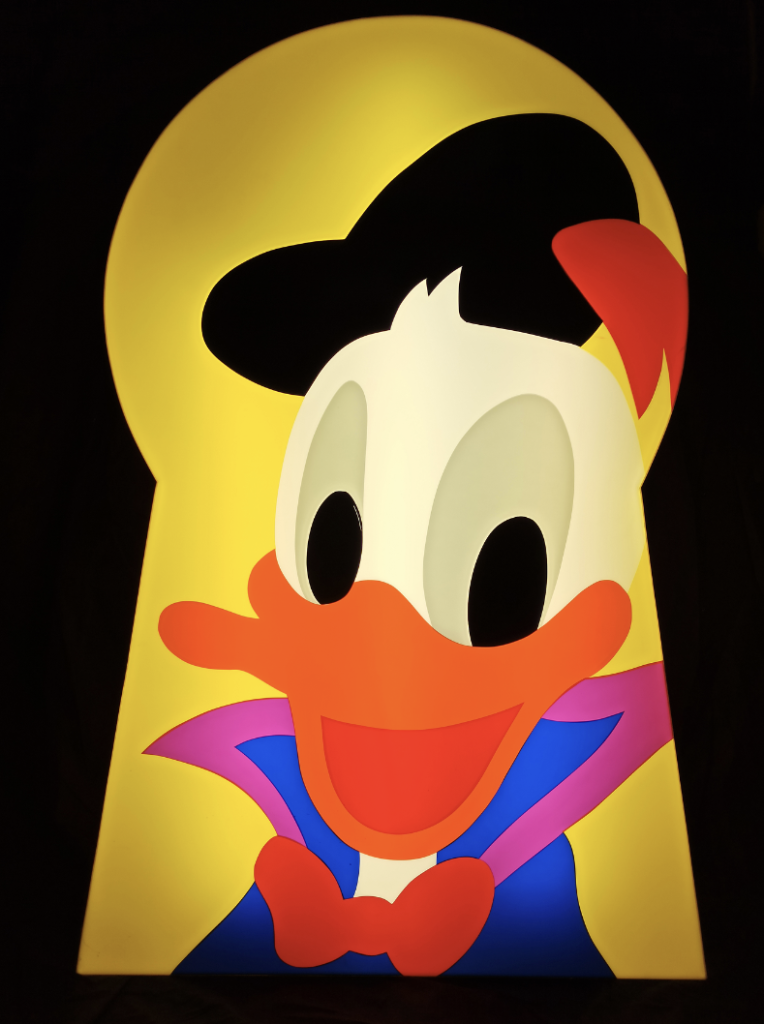
MARCO LODOLA
Paperino è, assieme a Topolino, uno dei personaggi più conosciuti ed amati di Walt Disney. Debutta ufficialmente nel 1934, parla in modo incomprensibile, è simpatico e combina pasticci con il suo caratteraccio. Marco Lodola, protagonista della Neo Pop Art degli anni ‘90, è amato non solamente per le sue tele, ma anche per le sue sculture luminose che si appropriano di miti e simboli della società, dell’arte e del fumetto, interpreta il famoso papero con il suo celebre sorriso. / Donald Duck is, along with Mickey Mouse, one of Walt Disney’s best known and most loved characters. He officially made his debut in 1934, speaks incomprehensibly, is likeable and messes with his temper. Marco Lodola, protagonist of the Neo Pop Art of the 90s, is loved not only for his canvases, but also for his luminous sculptures that appropriate myths and symbols of society, art and comics, he plays the famous duck with his famous smile.
MANUELA LUZI
Declinazioni sociali nella ripresa del Botticelli nell’opera, tutta digitale, di Manuela Luzi. La Venere si staglia in un mare di petrolio indossando una maschera antigas, simbolo del degrado ambientale causato dall’uomo. Inquinamento e interessi economici ci osservano prendendosi gioco di noi, proprio come fa Ronald McDonald. Se Botticelli ci parlava di una rinascita dell’amore e dell’uomo, la Luzi ci mostra ciò che, da una ri-nascita, rischia di tramutarsi in un clamoroso disastro per tutti noi. / Social variations in Botticelli’s reprise in the all-digital work by Manuela Luzi. Venus stands out in a sea of oil wearing a gas mask, a symbol of man-made environmental degradation. Pollution and economic interests watch us and make fun of us, just like Ronald McDonald does. If Botticelli spoke to us of a rebirth of love and man, Luzi shows us what, from a re-birth, risks turning into a resounding disaster for all of us.
RENATO MAMBOR
Protagonista del ritorno alla figurazione nei Sessanta, Mambor è sempre stato osservatore del mondo e dei suoi segnali. I suoi uomini timbro, che riflettevano sull’omologazione dell’uomo causata dalle mode e dalla pubblicità, sono stati realizzati ispirandosi al segnale di attraversamento pedonale che Mambor vedeva dal distributore di benzina nel quale lavorava: un segnale universalmente conosciuto che Mambor cita per dare inizio alla sua riflessione sull’uomo e sulla società. / Protagonist of the return to figuration in the Sixties, Mambor has always been an observer of the world and its signals. His stamp men, reflecting on the homologation of man caused by fashions and advertising, were made taking inspiration by the pedestrian crossing sign that Mambor saw from the gas station where he worked: a universally known sign that Mambor cites to start his reflection on man and society.
MAHATMA MARCHI
L’enorme Baloon dog, il cagnolino di Jeff Koons realizzato nel 1992, vuole essere un simbolo universale di amore divenuto incontrastata icona di contemporaneità. Mahatma Marchi si appropria dell’iconografia dell’artista statunitense per portarci in un’opera fatta di pop corn a richiamo anche della riflessione di Koons: entrambi gli artisti riflettono sul concetto di un materiale povero utilizzato in un concetto di democratizzazione dei materiali, cosa già avvenuta nell’opera di Andy Warhol. / The huge Baloon dog, Jeff Koons’ little dog made in 1992, aims to be a universal symbol of love, undisputed icon of contemporaneity. Mahatma Marchi appropriates the iconography of the American artist to bring us into a work made of popcorn also recalling Koons’ reflection: both artists reflect on the concept of a poor material used in a concept of democratization of materials, already occurred in the work of Andy Warhol.
ANDREA MENEGHETTI
Meneghetti taglia, seziona ed estrapola un materiale freddo come il ferro sintetizzando figure di antica memoria riempiendole di significati metafisici. Nelle sue mani il materiale si trasforma in materia in un continuo dialogo con il mondo circostante; interviene nella concretezza dell’arte modificandone il valore intrinseco dove i vuoti diventano dimensione determinante per la comprensione dei pieni. Una doppia vita è intrappolata in queste sculture, quella del conoscibile e quella rivolta ad un esistenzialismo tutto da scoprire. / Meneghetti cuts, dissects and extrapolates a cold material such as iron, synthesizing figures of ancient memory filling them with metaphysical meanings. In his hands the material is transformed into matter in a continuous dialogue with the surrounding world; he intervenes in the concreteness of art by modifying its intrinsic value where the voids become a decisive dimension for the understanding of the solids. A double life is trapped in these sculptures, that of the knowable and that of an existentialism to be discovered.
DANIELE NALIN
L’artista vuole qui denunciare le atrocità della guerra in un ciclo che iniziò durante lo scoppio della Guerra nel Golfo alla vista di una casa civile bombardata “per errore” Nalin si lega alle vicende storiche dell’umanità raccontandole attraverso il medium di una pittura che, nel nostro caso, rimanda al film di Francis Ford Coppola Apocalypse Now nella celebre scena degli elicotteri che si apprestano a bombardare sulle note della Cavalcata delle Valchirie di Wagner. / Here the artist wants to denounce the atrocities of the war in a cycle that started during the outbreak of the war in the Gulf at the sight of a civilian house bombed “by mistake”. Nalin binds himself to the historical events of humanity by telling them through the medium of a painting , in our case, referring to the film by Francis Ford Coppola Apocalypse Now in the famous scene of the helicopters that are preparing to bomb on the notes of Wagner’s Ride of the Valkyries.
OBEY
Il gigantesco Andrè the Giant è stato uno dei wrestler più conosciuti ed amati degli States. Il suo volto viene ripreso da Obey, nel 1989, per realizzare oltre un milione di stickers da attaccare in tutto il mondo nell’azione Andrè the Giant has a posse in cui il riferimento a Posse, inteso come banda/gruppo, è un termine diffuso nella comunità degli skaters dentro la quale Obey lavorava come illustratore. Inserendo il proprio logo sotto il volto del gigantesco wrestler, l’artista lancia il messaggio globale di obbedire al Gigante…. OBEY! The gigantic Andrè the Giant was one of the best known and most loved wrestlers in the States. His face is taken up by Obey, in 1989, to create over a million stickers to be attached all over the world in the action Andrè the Giant has a posse in which the reference to Posse, understood as a band / group, is a widespread term in the community of skaters where Obey worked as an illustrator. By placing his logo under the face of the gigantic wrestler, the artist launches the global message of obeying the Giant …. OBEY!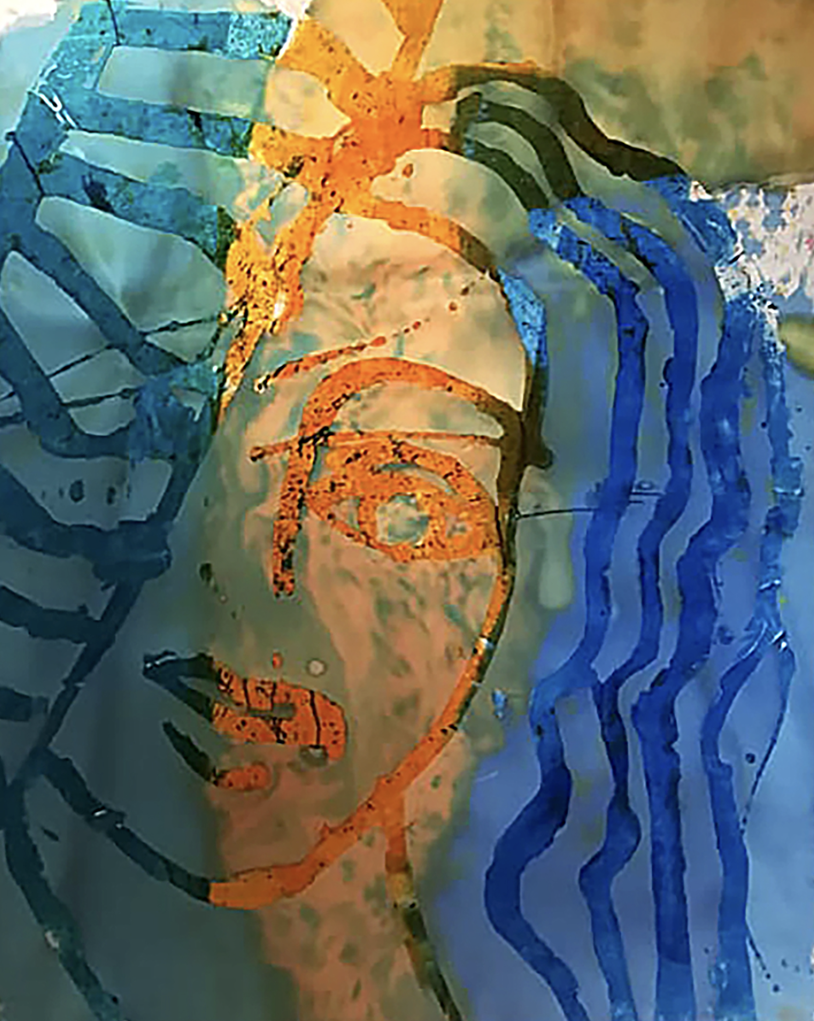
FRANCA PISANI
La Nascita di Venere del Botticelli viene immortalata da Franca Pisani su seta di Lione, tessuto usato per il restauro delle opere antiche. Una citazione, quindi, non solamente dell’opera, ma anche nell’utilizzo di un materiale che serve per curare le opere del passato. Le movenze e le cromie dell’artista di Pietrasanta offrono qui un esempio superlativo di una tecnica pittorica da sempre legata ai maestri del Rinascimento, con l’utilizzo di ossidi, biacca e di colori soavi ma, allo stesso tempo, energici. / Botticelli’s Birth of Venus is immortalized by Franca Pisani on silk from Lyon, a fabric used for the restoration of ancient works. A quotation, therefore, not only of the work, but also in the use of a material that is utilized to cure the works of the past. The movements and colors of the Pietrasanta artist offer here a superlative example of a painting technique always been linked to the masters of the Renaissance, with the use of oxides, white lead and gentle but, at the same time, energetic colors.
ELENA PROSDOCIMO
La Flora di Tiziano ed un paesaggio del Giorgione mixati in una ricerca fotografica legata alle simbologie dell’arte antica: Flora è la raffigurazione della Dea della Primavera vestita di fiori che, nel rivelarsi, scaccia il gelido inverno per inebriare di vita nuova ciò che la circonda. Questa figura porta con sé il germoglio del cambiamento, della fertilità e della femminilità stessa e viene inserita in un paesaggio in cui bellezza ed armonia confluiscono in un’atmosfera immobile, stoica e divina. / Flora by Titian and a landscape by Giorgione mixed in a photographic research linked to the symbolism of ancient art: Flora is the representation of the Goddess of Spring dressed in flowers who, in revealing herself, drives away the cold winter to inebriate with new life what surrounds. This figure carries with it the sprout of change, fertility and femininity itself and is inserted into a landscape where beauty and harmony come together in an immobile, stoic and divine atmosphere.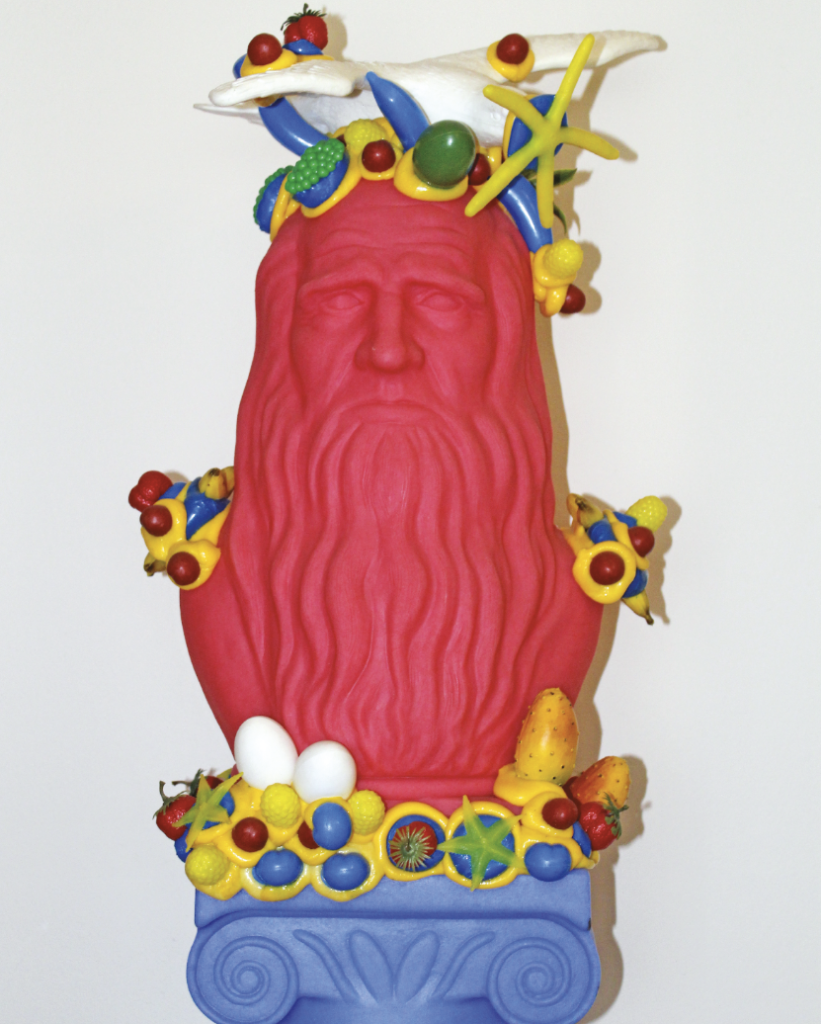
CARLO RIZZETTI
Leonardo da Vinci, grande genio e sperimentatore, viene qui omaggiato nella ripresa del suo iconico Autoritratto reinterpretato con un linguaggio crocevia tra dadaismo e pop art fino ai limiti del “kitsch”. La tecnica artistica è quella del processo cracking utilizzato per la produzione industriale della plastica. Come viene rievocata una delle figure perno dell’arte cinquecentesca, anche la tecnica ci parla di un ritorno: quello di un mondo preistorico contenuto nel petrolio riportato in vita grazie al linguaggio dell’arte. / Leonardo da Vinci, great genius and experimenter, is honored here in the revival of his iconic Self-portrait reinterpreted with a crossroads language between Dadaism and pop art up to the limits of “kitsch”. The artistic technique is that of the cracking process used for the industrial production of plastic. As one of the pivotal figures of sixteenth-century art is recalled, even the technique speaks to us of a return: that of a prehistoric world contained in oil brought back to life thanks to the language of art.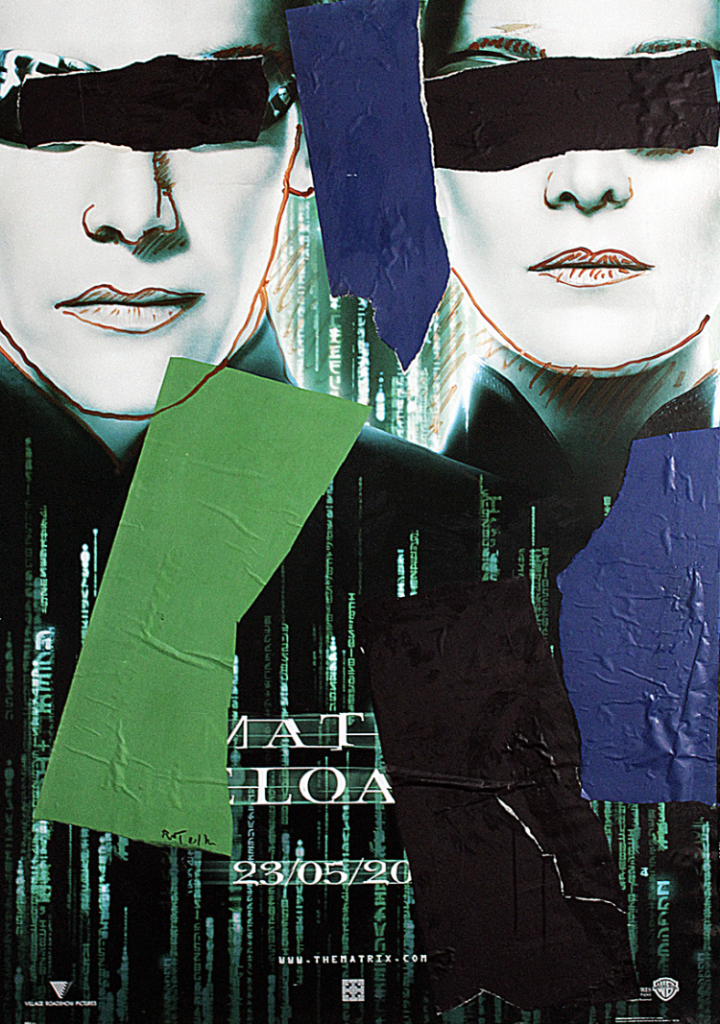
MIMMO ROTELLA
La nota trilogia di Matrix diretta dalle sorelle Wachowski viene ripresa dal protagonista del Nouveau Réalisme Mimmo Rotella. In questo lavoro Rotella si appropria del poster del film strappandolo dalla strada per traslarlo nel mondo dell’arte attraverso la tecnica del collage. Il manifesto cinematografico, ora applicato sulla tela, assume una nuova identità e si eleva ad opera d’arte che celebra l’immaginario collettivo attraverso i crismi della riflessione contemporanea. / The well-known Matrix trilogy directed by the Wachowski sisters is taken up by the protagonist of the Nouveau Réalisme Mimmo Rotella. In this work, Rotella appropriates the film poster by tearing it off the street to translate it into the world of art through the technique of collage. The film poster, now applied to the canvas, takes on a new identity and is elevated to a work of art that celebrates the collective imagination through the trappings of contemporary reflection.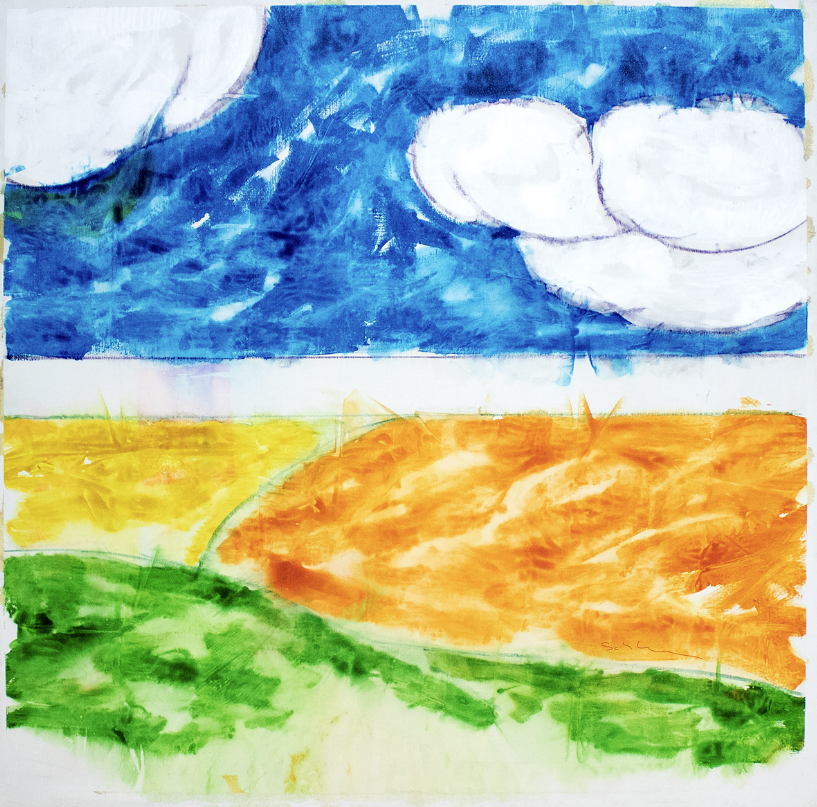
MARIO SCHIFANO
Gli anni Settanta di Mario Schifano si manifestano nei Paesaggi anemici con una struttura piatta e quasi priva di dimensione naturalistica; una pittura in cui viene celebrata l’assenza di materia pittorica che può avvicinarsi alle morbide stesure dei paesaggi di Ferdinand Hodler, capace di donarci soavi poesie di una natura mistica che spesso risulta deformata dalla sintesi di un colore che, nel pittore svizzero, porta alle massime vette di un simbolismo meditativo e ampiamente concettuale. / Mario Schifano’s seventies are manifested in the Paesaggi anemici with a flat structure and almost devoid of naturalistic dimension; a painting in which the absence of pictorial material is celebrated which can come close to the soft drafts of Ferdinand Hodler’s landscapes, capable of giving us sweet poems of a mystical nature which is often deformed by the synthesis of a color which, in the Swiss painter, leads to highest peaks of a meditative and broadly conceptual symbolism.
ENRICO SCHINETTI
La serie di 15 xilografie di Dürer dedicate all’Apocalisse rappresenta una splendida interpretazione del desiderio di infliggere la sofferenza impresso nei volti dei quattro cavalieri. Schinetti si appropria della composizione di Dürer interpretandola con un impianto visionario capillare e ritmico. Il dinamismo dei corpi, la mostruosità dei personaggi e degli animali, la violenza e l’orrore descritti diventano fondamentali per donarci la materia esplosiva che moltiplica la visionarietà del racconto. / Dürer’s series of 15 woodcuts dedicated to the Apocalypse represents a splendid interpretation of the desire to inflict suffering imprinted on the faces of the four horsemen. Schinetti appropriates Dürer’s composition by interpreting it with a capillary and rhythmic visionary system. The dynamism of the bodies, the monstrosity of the characters and animals, the violence and horror described become fundamental to give us the explosive material that multiplies the visionary nature of the story.
GIANGIACOMO SPADARI
Queste opere fanno parte della raccolta che Giangiacomo Spadari fece con Arturo Schwarz, nel 1972, tratta da opere originali del 1969. Non importa più chi siano questi personaggi o che cosa abbiano significato nella storia degli uomini, resta la bellezza della pittura di Spadari, e la bellezza è sempre dei sognatori. Dirà l’artista: “Sono cresciuto tra le immagini della storia e i ritratti dei loro personaggi. A volte politici, a volte della cultura e altre del cinema.” / These works are part of the collection that Giangiacomo Spadari made with Arturo Schwarz, in 1972, from originals from 1969. It no longer matters who these characters are or what they have meant in the history of men, the beauty of Spadari’s painting remains, and the beauty it is always dreamers. He will say the artist: “I grew up between the images of history and the portraits of their characters. Sometimes politicians, sometimes culture and other cinema.”
CESARE TACCHI
Marilyn Monroe è protagonista dell’appropriazione artistica di un altro caposaldo del ritorno all’immagine propria degli anni Sessanta: Cesare Tacchi. Il suo percorso nella “realtà dell’immagine”, intrapreso con gli smalti su tela e proseguito con la straordinaria invenzione dei quadri estroflessi realizzati in forma di tappezzerie, ci regala l’icona di un’attrice amata e, allo stesso tempo, maledetta qui ritratta in uno dei suoi sorrisi più celebri. / Marilyn Monroe is the protagonist of the artistic appropriation of another cornerstone of the 1960s’ return to the image: Cesare Tacchi. His journey into the “reality of the image”, undertaken with enamels on canvas and continued with the extraordinary invention of the everted paintings made in the form of tapestries, gives us the icon of a beloved and, at the same time, cursed actress here portrayed in one of his most famous smiles.
MAURIZIO TAIOLI
Abile ladro di contemporaneità, Taioli fonda la propria ricerca sull’appropriazione dell’immaginario collettivo: dal fumetto, dalla storia dell’arte o dall’architettura. Lo splendido San Sebastiano di Mattia Preti conservato al Museo di Capodimonte di Napoli viene ripreso da Taioli attraverso li sezioni di bidimensionalità proprie della Pop Art, con l’obiettivo di togliere i riferimenti plastici al soggetto utilizzato. Dalla tenebrosa pittura del Seicento agli esplosivi colori dei giorni nostri. / A skilled thief of contemporaneity, Taioli bases his research on the appropriation of the collective imagination: from comics, from the history of art or from architecture. The splendid San Sebastiano by Mattia Preti preserved in the Capodimonte Museum in Naples is taken up by Taioli through the two-dimensional sections of Pop Art, with the aim of removing the plastic references to the subject used. From the gloomy painting of the seventeenth century to the explosive colors of today.
DARIO TIRONI
Ritratta seguendo canoni estetici e proporzionali dei modelli greci antichi, classici ed ellenistici, la Bagnante di Allegrain posa con estrema grazia e sensualità cercando di coprirsi con l’abito. Tironi si appropria di questa grazia per lanciare una chiara denuncia sociale: la Terra rischia di trasformarsi da paradiso terrestre in un pianeta violentato dall’inquinamento ambientale. La perfezione divina si riempie di frammenti, prodotti e rifiuti che l’umanità getta via senza rimorso. / Portrayed following the aesthetic and proportional canons of ancient Greek, classical and Hellenistic models, Allegrain’s Bather poses with extreme grace and sensuality, trying to cover herself with her dress. Tironi appropriates this grace to launch a clear social denunciation: the Earth risks transforming itself from an earthly paradise into a planet raped by environmental pollution. Divine perfection is filled with fragments, products and waste that humanity throws away without remorse.
LUCA TRUCCA
Le pittura digitale incontra la pittura del XVII secolo attraverso sezioni, teatralità e rivisitazione di una sacralità dal delicato retrogusto surrealista. Luca Trucca ci porta in ambientazioni trasversali di seducente memoria visiva operando una vera e propria messa in scena di una storia sacra che, oggi, si trasforma in apparato simbolico atto a rivelare, anzichè nascondere, l’intima natura di un poeta che ama in modo viscerale l’arte tanto da impersonificare i protagonisti delle proprie opere. / Digital painting meets 17th century painting through sections, theatricality and a revisitation of a sacredness with a delicate surrealist aftertaste. Luca Trucca takes us into transversal settings of seductive visual memory by operating a real staging of a sacred story which, today, is transformed into a symbolic apparatus able to reveal, rather than hide, the intimate nature of a poet who loves so visceral art so much to impersonate the protagonists of his works.
ERMES TERSO VANZAN
La Canestra di Frutta rappresenta uno dei punti di partenza di quello che sarà il Realismo caravaggesco. Pensata come metafora del memento mori, quest’opera è considerata la prima natura morta della storia dove la precarietà dell’esistenza è celebrata con l’imperfezione della natura. Vanzan ribalta i significati e ripensa l’opera attraverso un’estasi compositiva iper-realista che porta il colore ad essere emblema di vita e di rinascita attraverso stesure limpide ed incontaminate che portano ad una natura rigenerata e ricolma di vita. / The Basket of Fruit represents one of the starting points of what was to be Caravaggio’s Realism. Conceived as a metaphor for the memento mori, this work is considered the first still life in history where the precariousness of existence is celebrated with the imperfection of nature. Vanzan overturns the meanings and rethinks the work through a hyper-realistic compositional ecstasy that brings color to be an emblem of life and rebirth through clear and uncontaminated drafts that lead to a regenerated nature full of life.
ERMES TERSO VANZAN
Riflessioni caravaggesche anche per quest’opera di Vanzan che, come nel caso di Roy Lichtenstein, cita non solo l’iconografia ma lo stile stesso del promotore del Realismo. Caravaggio viene declinato con un’impianto pittorico solido ed evocativo che amplia il suo orizzonte nella sfera metafisica e surrealista grazie a ripetute aperture dello sguardo; angoli, dettagli e anfratti misteriosi muovono le stesure prospettiche in sinossi mistiche ricolme di allusioni e significati. / Caravaggesque reflections also for this work by Vanzan who, as in the case of Roy Lichtenstein, cites not only the iconography but the style of the promoter of Realism. Caravaggio is declined with a solid and evocative pictorial system that broadens its horizon in the metaphysical and surrealist sphere thanks to repeated openings of the gaze; corners, details and mysterious ravines move the perspective drafts in mystical synopses full of allusions and meanings.
MR. WANY
L’opera si fonda sull’appropriazione dello stile dei manga giapponesi e del celebre fumetto Astro Boy realizzato da Osuma Tezuka tra il 1952 ed il 1968. Il termine Anime (cartoon giapponesi) deriva dalla prima edizione del cartoon di Astro Boy. Mr. Wany, artista che opera nel mondo della Street Art, recupera un linguaggio divenuto universale portandolo nella sfera dell’inconscio e del sogno grazie al recupero di un materasso, oggetto reale che ci conduce ad oltrepassare il confine tra sogno e realtà. / The work is based on the appropriation of the style of Japanese manga and the famous Astro Boy comic created by Osuma Tezuka between 1952 and 1968. The term Anime (Japanese cartoon) derives from the first edition of the Astro Boy cartoon. Mr. Wany, an artist working in the world of Street Art, recovers a language that has become universal, bringing it into the sphere of the unconscious and the dream thanks to the recovery of a mattress, a real object leading us to cross the boundary between dream and reality.
ANDY WARHOL
Oltre alle sue celebri favole Andersen amava ritagliare da fogli di carta di tutti i colori un infinito bestiario di soggetti: creature, mostri, ballerini, edifici esotici che evocano irresistibilmente le sue storie e ora conservati al Museo di Odense. Questi ritagli ispirarono a tal punto la fantasia di Warhol che decise di prenderli come soggetto per realizzare una serie di opere in cui il ritaglio è posto su uno sfondo tenue che ne esalta intensità e vivacità rendendolo l’unico protagonista della composizione. /
In addition to his famous fairy tales Andersen loved to cut out an infinite bestiary of subjects from sheets of paper of all colors: creatures, monsters, dancers, exotic buildings that irresistibly evoke his stories, now preserved in the Odense Museum. These cutouts inspired Warhol’s imagination to such an extent that he decided to take them as the subject to create a series of works where the cutout is placed on a soft background that enhances its intensity and liveliness, making it the only protagonist of the composition.